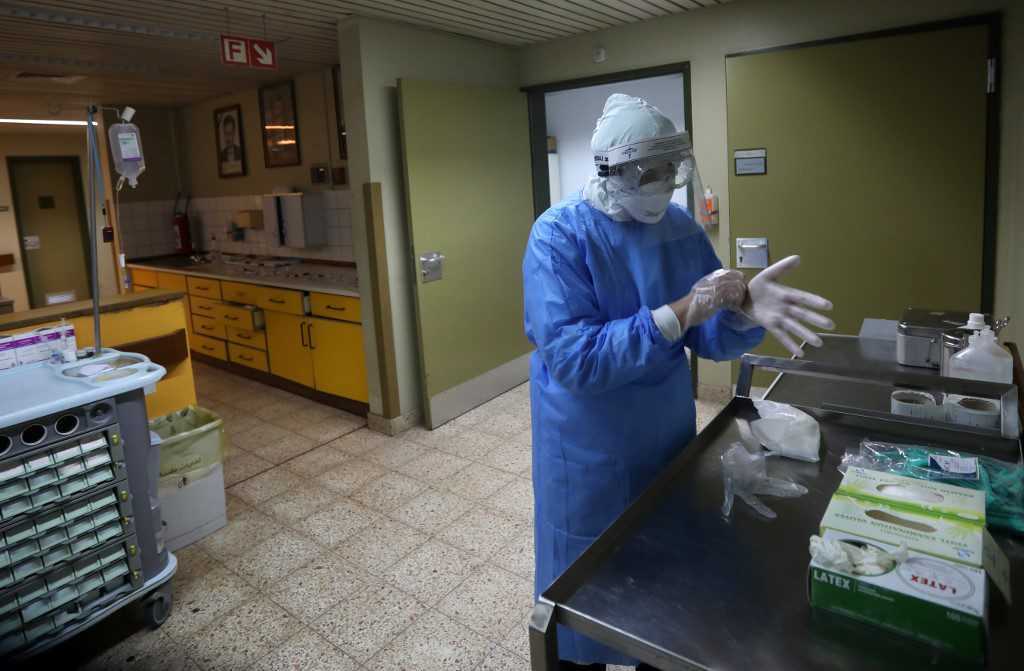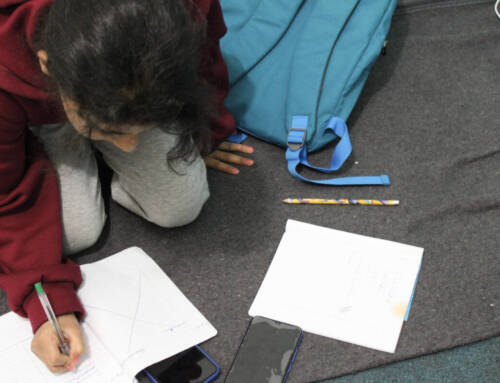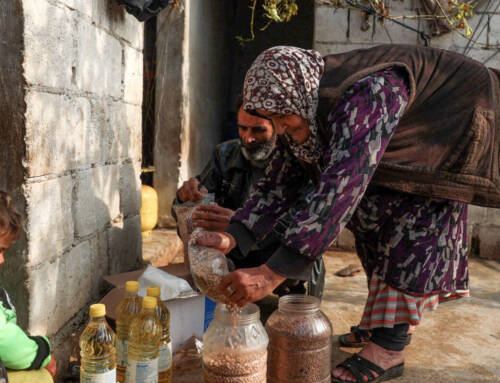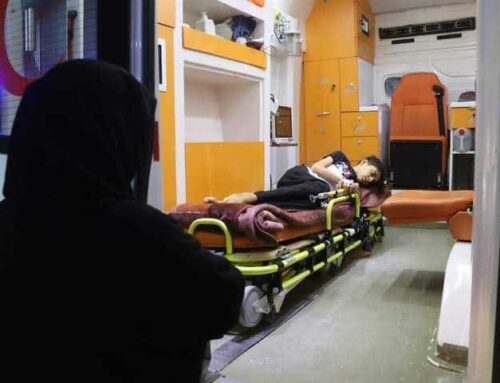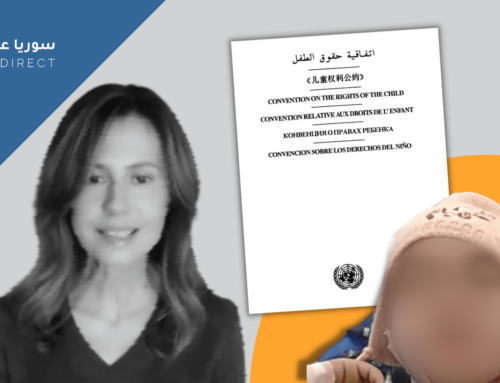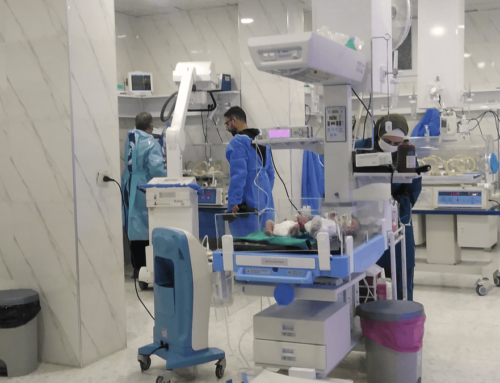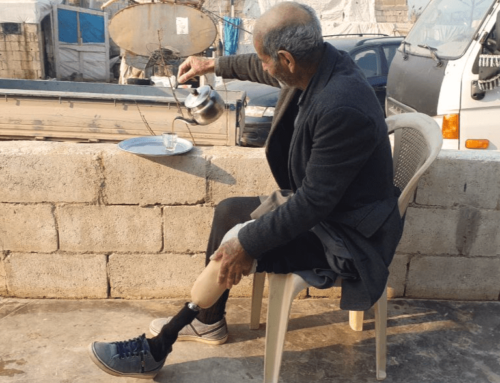Syria’s COVID-19 vaccine is expected by April, but fair access is not guaranteed
Ahead of the vaccination rollout, humanitarian actors warn of the risk of discriminatory practices in the distribution of the vaccine if Damascus is given free rein.
14 January 2021
A member of the medical staff of Al-Assad University Hospital in Damascus, puts on protective gloves at the special department designated for the testing of people with symptoms of the COVID-19, 15/4/2020 (AFP)
AMMAN, BEIRUT — Syria is not faring well in the race to procure the COVID-19 vaccine. While 30 million people have already been vaccinated in 50 countries, the vaccine is expected to arrive in Syria by April, or at the latest by June.
On Tuesday, the Syrian government agreed on the distribution mechanism of the vaccine, but details have not yet surfaced. Ahead of the vaccination rollout, humanitarian actors warn of the risk of discriminatory practices in the distribution of the vaccine if Damascus is given free rein.
The Ministry of Health (MoH) applied to get the vaccine through the COVAX program (COVID-19 Vaccines Global Access Facility) last December. As a low-income country, Syria is eligible to receive the vaccine for free through this initiative.
Led by the World Health Organization (WHO), the Coalition for Epidemic Preparedness Innovations (CEPI) and the Vaccine Alliance (Gavi), the COVAX program aims to secure two billion vaccine doses by the end of 2021, of which one billion are set aside for 92 low- and middle-income countries. These will receive free doses – although they may need to cover part of the delivery cost with up to $2 per dose.
In 2020, the COVAX facility raised $2 billion and invested in ten vaccine candidates, including Moderna and Oxford/AstraZeneca. COVAX expects to begin the vaccination rollout by April 2021, but at least $4.6 billion are still needed to procure doses for poor countries, a gap that could hinder the response. In the case of Syria, out of $179 million required for the COVID-19 operation response plan (procuring testing kits and personal protective equipment), only $77.9 million have been raised.
The Russian alternative?
Since the launch of Russia’s “Sputnik” vaccine, Syrian state media has been fueling hopes of a Russian solution.
In October 2020, Assad affirmed that the regime “would negotiate the import of the coronavirus vaccine with Russian authorities as soon as it becomes available.” However, COVAX has not invested in the Sputnik vaccine. To receive it, Syria would have to purchase it from Russia directly, an unlikely proposition in light of Syria’s current dire financial state – unless Russia donates doses in order to promote its vaccine.
COVAX encourages wealthier countries to donate doses, but donations must not be earmarked “for specific populations and geographies,” meaning that COVAX would not support Russian vaccine donations going exclusively to Syria.
Battling COVID-19 in a war-ravaged country
The regime-held areas account for 5,602 active COVID-19 cases and have registered 799 deaths, but “only 1.5%” of the deaths related to COVID-19 are reported,” Dr. Houssam al-Nahhas, Middle East and North Africa Researcher at Physicians for Human Rights (PHR), told Syria Direct. Al-Nahhas added that some physicians who tried to speak out about the pandemic’s magnitude were intimidated, sometimes through physical violence.
The war and economic situation hamper Syria’s ability to ensure the cold chain needed to preserve the vaccine. “The necessary equipment and regular electricity supply are not always reliable across all locations in Syria, which is essential for vaccination plans,” Hasan Nabulsi, Communication Officer at UNICEF, told Syria Direct.
After a decade of war, only 65% of the public hospitals are fully functioning. In Daraa province, for instance, two years after reconciliation, just one of eight public hospitals is fully functional.
Northwest Syria, an area outside Damascus’s control, hosts 4.2 million people, but the testing capacity is around 1,000 tests daily. This lack of capacity does not allow for building a “clear image about the spread of the pandemic,” according to Firas al-Fares, program manager at the Syrian Expatriates Medical Association (SEMA).
This adds to the difficulty of procuring personal protective equipment (PPE) for healthcare workers. “Out of 600 doctors in northwest Syria, 273 have been infected, and 20 passed away,” al-Fares said. This Syrian doctor, currently based in Turkey, estimates that 300 beds are available in northwest Syria to treat severe Covid-19 cases across seven hospitals. The occupancy rate currently stands at 60%, but he expects a peak of cases at the end of January, similar to the November 2020 peak when the occupancy reached 100%.
In 2020, the closure of three of four border crossings severely restricted the flow of cross-border aid. “Relying on one gate to supply the entire north of Syria will not be enough, especially when the vaccine starts to arrive in the area,” al-Nahhas warned.
In the meantime, efforts led by the Syria Immunization Group (SIG) are underway to procure the vaccine for the northwest. The SIG is a local grouping of health organizations formed in 2013 during a polio outbreak, including the Idlib Health Authority and Aleppo Health Authority. The SIG is responsible for the provision of routine immunization there. It receives vaccines directly from UNICEF, according to Fadi Hakim, Advocacy Manager at the Syrian American Medical Society (SAMS) in Idlib.
“The SIG submitted a formal proposal to Gavi-COVAX to procure doses for 20% of the overall population of Greater Idlib, covering 700,000 people,” Hakim said. Frontline medical staff (3% of the population), those over 60 years old (7.5%) and those between 20 and 60 with comorbidities (9.5%) are prioritized,” Emad Zahran, from the Idlib Health Directorate, told Syria Direct.
According to Hakim, in the proposal, SIG included criteria for a vaccine suited to the humanitarian context, including a storage temperature above 8 degrees Celsius.
The risk of weaponization of the vaccine
During the COVID-19 pandemic, “Human Right Watch (HRW) has documented the discriminatory distribution of masks, gloves and protective equipment,” said Sara Kayyali, Syria researcher at HRW. She also pointed out that testing capacities in northeast and northwest Syria “are very low compared with areas held by the Syrian government.”
PHR also spoke to informants who reported cases where testing kits donated by China and Russia to the Syrian government were later found “being sold for $100 or $200,” al-Nahhas said.
Similar diversion of aid is feared to impact the distribution of the vaccine, leaving priority groups – health care workers, people with underlying health conditions and those over 65 years old – at the mercy of geopolitical or economic calculus.
“We are concerned that should the UN deal with the Syrian government as the primary partner, the vaccine will arrive in northeast and northwest Syria very late,” Kayyali said. Further, “our main concern is that areas retaken by the government will not be on the priority list for the vaccination, if at all,” according to al-Nahhas.
Beyond geography, inequity may stem from corruption and ‘wasta’ (influence). During the pandemic, HRW documented the birth of a black market of PPE and oxygen canisters. “If the doses are limited, they will go to the elites, people who are able to pay, people in Damascus. We have seen the same thing happen with the PPE,” said Kayyali.
Many had to bribe doctors “to be admitted to the hospital and buy out of pocket the supplies they need; people with wasta will be able to access healthcare, and it will be the same for the vaccine,” al-Nahhas forecast.
Security concerns may also hamper access to the vaccine. For instance, those blacklisted, living undercover, with a reconciliation card or who have not done the mandatory military service may “be hesitant to visit public health centers,” al-Nahhas said, given the risk of encountering police officers or others with ties to security agencies there. “If it requires traveling to Damascus, that means people will have to go through checkpoints, and this is also another layer of risk.”
The spotlight to ensure an equitable distribution of the vaccine is on the international organizations and UN agencies that will partner with Syrian authorities to implement the vaccination plan.
“My primary recommendation to UN agencies would be to ensure that the discriminatory aid system that has prevailed in Syria this far does not prevail in terms of the distribution of the vaccine,” Kayyali said.
“UN agencies have to put more pressure on the Syrian Government for more transparent distribution, allowing for monitoring of vaccination,” said al-Nahhas, who called on healthcare providers “to not submit to the pressures the government is putting to limit their ability to access all areas and all citizens in the country.” He added that he was “not optimistic on how the vaccine will be distributed.”
Contacted by Syria Direct, WHO Syria assured that “there are joint efforts between MoH, WHO, UNICEF and GAVI to plan for the COVID-19 vaccine introduction. This plan does not exclude any population groups or any areas in the country.” Specifically, WHO said the immunization campaign will utilize immunization cards and registers, as well as monitor the consumption and “wastage of vaccines in each service delivery point.”

